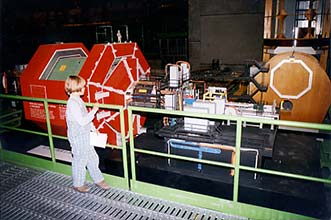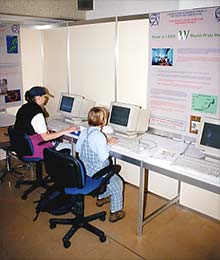CERN Laboratories |
||||||||||||||||||||
|
||||||||||||||||||||
George |
||||||||||||||||||||
|
We began our odyssey six months earlier visiting the world’s largest astronomical observatory on the tallest mountain in Hawaii. It was a place devoted to pure science, a place where the world’s governments, universities and businesses had cooperated to create an eye into the farthest reaches of our macro universe, and to discover how it all began. Halfway around the world we visited another similar place, CERN, in Geneva, Switzerland. This time, instead of climbing a mountain, we descended into the earth to visit the world’s largest particle physics laboratory. Here too governments, universities and businesses from all over the world were working cooperatively to create an eye into the farthest reaches of our micro universe, and to better understand how it all is made. |
||||||||||||||||||||
|
CERN is a sprawling area that snakes under the borders between Switzerland and France. It was founded in 1954 to prevent the "brain drain" of top scientists and engineers to America where the cutting edge of the new nuclear science was flourishing. Now CERN counts 19 member states, and over half of the world’s particle physicists representing 500 universities and more than 80 nationalities. And like the Keck Observatory, these men and women are also doing pure science, the purest form of science. Their search is an attempt to answer the most fundamental questions of the universe: what is it made of, and how is it made? CERN is also the place that invented the World Wide Web, the means by which you are reading these pages. |
||||||||||||||||||||
|
CERN’s largest accelerator, the LEP (Large Electron Positron collider) is buried 100 meters beneath the earth in a cement tunnel 27 kilometers in circumference. Through most of the year this tunnel is sealed shut; however, our visit coincided with the annual cleaning, thus allowing us to see first hand this remarkable technology. Within the tunnel is a metal tube about 10 inches in diameter. It looks like normal plumbing, except that surrounding it are devices and machines that appear to be borrowed from a George Lucas movie set. It is within this tube that the secrets of the universe are unfolding. Using powerful electric fields, energy is "pushed" into a beam of particles that are blasted around the tube, guided and accelerated by special magnets. The beam of particles is accelerated to near the speed of light, zipping around the 27 kilometers 11,000 times a second, gaining energy in their headlong proof that E=mc2. And then the beam is directed to hit a target, either another beam heading its way, or into a waiting particle. Wham, bang, thank you ma’am, the particles are ripped asunder. And in that instant they reveal the strangest truths. Like an auto crash where bumpers, headlights and other parts fly every way, these particles too give off their parts in telling ways, into a story that is at the heart of reality and everything in the universe. |
|
|||||||||||||||||||
|
CERN is busy working on building yet a larger accelerator, the LHC (Large Hadron Collider). It’s expected to be completed and starting its critical work in 2004. Using superconductivity, this new accelerator will help unlock remarkable secrets such as the riddle of mass and the enigma of antimatter. For us simple travelers across our planet, the remarkable efforts and resources necessary to build Keck Observatory and CERN stagger our minds. Both of these mega-projects are the results of thousands of brilliant people’s finest thinking, finest dreaming. Working together, building on each other’s insights, both of these projects represent the culmination of tens of thousands of years of human endeavor that began long before the first stones of Stonehenge were leaned up on end. On our journey we saw several archeological observatories, in Thailand, India, Greece and Egypt. Places where the thinkers of the day once stood to admire the heavens and ponder on what we are, the nature of reality, and the course of our fate. And there atop lofty Mauna Loa, and there beneath the Swiss and French countryside, the thinkers of our day are doing the same. |
||||||||||||||||||||
|
Visit: http://www.cern.ch/ |
||||||||||||||||||||


